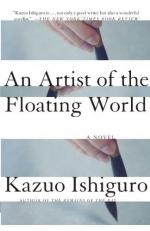|
This section contains 664 words (approx. 2 pages at 400 words per page) |

|
An Artist of the Floating World Summary & Study Guide Description
An Artist of the Floating World Summary & Study Guide includes comprehensive information and analysis to help you understand the book. This study guide contains the following sections:
This detailed literature summary also contains Topics for Discussion on An Artist of the Floating World by Kazuo Ishiguro.
An Artist of the Floating World is a novel by British-Japanese author Kazuo Ishiguro. It was published in 1986 and shortlisted the same year for the Booker Prize. The novel also won the Whitbread Book of the Year Award the year it came out.
Masuji Ono is a retired artist who has earned a high degree of prestige with his art. When negotiations over his daughter’s marriage falter though, he has to confront the possibility that his actions as a nationalist propagandist for the government during the war might have undermined his status. Masuji Ono sets about visiting the artists he worked with, and he even tries to set things right with one artist, Kuroda, who was arrested because of Masuji Ono’s doubts about his loyalty. When Masuji Ono concludes his actions were wrong and lamentable, he nevertheless finds his family wants to get back to a prosperous, normal life. They would rather believe in his prestige, without considering the questionable nature of his involvement in the war.
Masuji Ono lives in a house that once belonged to a prominent artist; he won the house in an ‘auction of prestige’ with other bidders for the property. But Masuji Ono’s retirement is marred by the difficulty he is having in marrying off his younger daughter, Noriko. A year ago, a family had abruptly backed out of the marriage negotiations and while Masuji Ono thinks the family pulled out because of their lower status, his daughters wonder whether there is something in his background that pushed the family away.
This begins a slow and deliberate inquiry into Masuji Ono’s past, and the reader learns Masuji Ono was once an artist of the ‘floating world’ of geishas and drink and romance and entertainment. As Japan became more and more nationalist in the 1930s, he turned from art to nationalist propaganda, and became a prominent leader of the artists calling for Japanese nationalism and imperial expansion.
In the post-war years, where many houses and even whole neighborhoods are devastated by bombing, this is no longer a popular position to take. Masuji Ono’s son-in-law violates propriety by expressing frustration with the older generation, who sent the young men off to die, and lived safely through the war. There is even talk of the leaders who have since committed suicide, as a way to apologize for their role in the disastrous war.
As Masuji Ono follows his conscience back into the past, in flashbacks and in visits to old comrades, he eventually sees his role in the national disaster. During a formal dinner with another suitor’s family, he announces he is willing to accept the fact his art may have had a bad influence.
This is not the end of the novel, though, for Masuji Ono still has old scores to settle, and Ishiguro still has material to work with. Masuji Ono is rebuffed when he goes to visit the house of one of his former students—his most promising student—who had been arrested during the war. Masuji Ono himself had reported this artist’s questionable loyalties, but imprisonment has injured the man, and he is not willing to reconcile with Masuji Ono. When Masuji Ono speaks with his daughter about his role in the war, she refuses to acknowledge any question about his virtues, and insists on remembering only his prestige.
It is only with an old colleague that Masuji Ono finds a real sympathy and understanding. Matsuda had initiated Masuji Ono into the nationalist movement, and now, as older men, they agree about their role in the war. But even though they regret their actions, they know they acted in good faith at the time, and because they have found some forgiveness and understanding, they are able to find some redemption in the fact they had at least tried something rare and difficult, instead of just playing it safe, like many of the artists with whom they worked.
Read more from the Study Guide
|
This section contains 664 words (approx. 2 pages at 400 words per page) |

|



